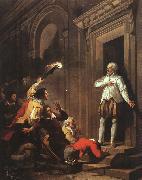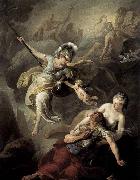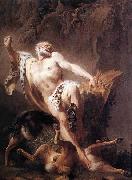
|
Artists
Index
|
||
|
Joseph Benoit Suvee
|
||
|
La Mort dAmiral de Coligny Joseph Benoit Suvee1.jpg ID de tableau:: 3711 |
1787 Musée des Beaux Arts, Dijon | |
| |
|
|
|
|
||
|
The Combat of Mars and Minerva new16/Joseph Benoit Suvee-683525.jpg ID de tableau:: 43991 |
1771 Oil on canvas, 143 x 104 cm | |
| |
|
|
|
|
||
|
Milon of Crotona new18/Joseph Benoit Suvee-899576.jpg ID de tableau:: 51088 |
Oil on canvas, 261 x 200 cm | |
| |
|
|
|
|
||
|
Invention of the Art of Drawing new21/Joseph Benoit Suvee-344244.jpg ID de tableau:: 64188 |
1791 Oil on canvas, 267 x 131,5 cm Groeninge Museum, Bruges A number of Bruges painters earned international renown during the neoclassical period, forming what might justly be called a Bruges school of Neoclassicism. Joseph B. Suvee even won the Prix de Rome, beating Jacques-Louis David into second place. He later became a member of the Academie Royale de Peinture et de Sculpture in Paris and director of the Academie de France in Rome. It was largely thanks to his efforts as a teacher in Paris and Rome that a succession of former pupils of the Bruges Academy were able to embark on international careers. In the painting traditionally titled The invention of the Art of Drawing, Suvee tells the well-known story of the daughter of the Greek potter Butades, who draws the shadow silhouette of her lover. This rational, balanced composition can be seen as a symbolic illustration of the Platonic aesthetic theory that underpinned classical art - art as shade of reality. , Artist: SUVeE, Joseph-Benoit , Invention of the Art of Drawing , 1751-1800 , Flemish , painting , mythological | |
| |
|
|
|
|
||
1 | Artiste précédent | |
|
Also Buy::. For Following Paintings / Artists / Products, Please Use Our Search Online: |









